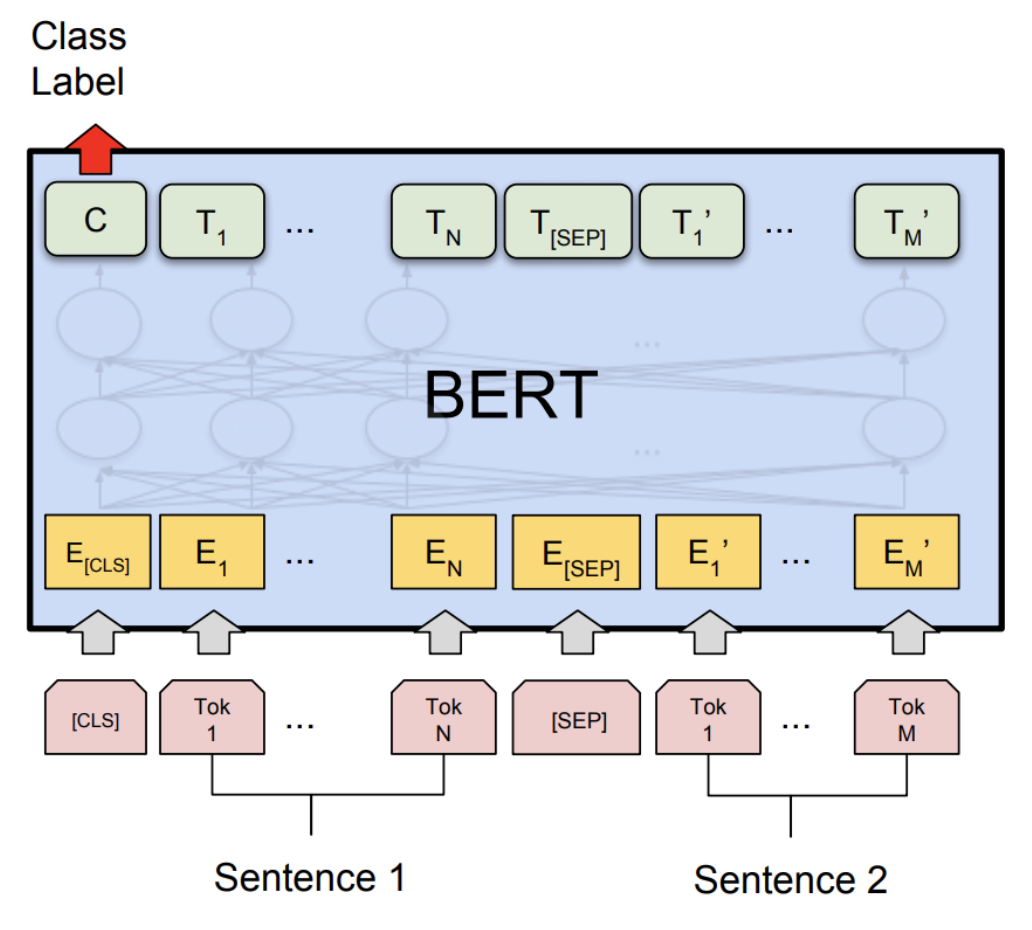Introduction
在本教程中,我们将紧跟HuggingFace Transformers示例中的BERT模型,对BERT模型应用动态量化。通过这一循序渐进的过程,我们将演示如何将BERT等众所周知的最新模型转换为动态量化模型。
- BERT,或者说Transformers的双向嵌入表示法,是一种预训练语言表示法的新方法,可以在许多流行的自然语言处理(NLP)任务(例如问题解答,文本分类,和别的。原始文件可以在这里找到 。
- PyTorch中的动态量化支持将浮点模型转换为具有静态int8或float16数据类型的权重和动态量化的量化模型。当权重量化为int8时,激活(每批)动态量化为int8。在PyTorch中,我们有torch.quantization.quantize_dynamic API,该API用仅动态权重的量化版本替换了指定的模块,并输出了量化的模型。
- 我们 在通用语言理解评估基准(GLUE)中展示了Microsoft Research Paraphrase Corpus(MRPC)任务的准确性和推理性能结果 。MRPC(Dolan和Brockett,2005年)是从在线新闻源中自动提取的句子对的语料库,带有人工注释,说明句子中的句子在语义上是否等效。由于班级不平衡(68%积极,32%消极),我们遵循常规做法并报告 F1得分。MRPC是用于语言对分类的常见NLP任务,如下所示。

1. Setup
1.1 Install PyTorch and HuggingFace Transformers
要启动本教程中,我们首先按照PyTorch安装说明这里和HuggingFace Github上回购这里。此外,我们还将安装scikit-learn软件包,因为我们将重用其内置的F1分数计算帮助器功能。
pip install sklearn pip install transformers
由于我们将使用PyTorch的Beta版部分,因此建议安装最新版本的Torch和Torchvision。可以在此处找到有关本地安装的最新说明。例如,要在Mac上安装:
yes y | pip uninstall torch tochvision yes y | pip install --pre torch -f https: / /download.pytorch.org/whl /nightly/cu 101/torch_nightly.html
1.2 Import the necessary modules
在这一步中,我们将导入本教程所需的Python模块。
from __future__ import absolute_import, division, print_function
import logging
import numpy as np
import os
import random
import sys
import time
import torch
from argparse import Namespace
from torch.utils.data import (DataLoader, RandomSampler, SequentialSampler,
TensorDataset)
from tqdm import tqdm
from transformers import (BertConfig, BertForSequenceClassification, BertTokenizer,)
from transformers import glue_compute_metrics as compute_metrics
from transformers import glue_output_modes as output_modes
from transformers import glue_processors as processors
from transformers import glue_convert_examples_to_features as convert_examples_to_features
# Setup logging
logger = logging.getLogger(__name__)
logging.basicConfig(format = '%(asctime)s - %(levelname)s - %(name)s - %(message)s',
datefmt = '%m/%d/%Y %H:%M:%S',
level = logging.WARN)
logging.getLogger("transformers.modeling_utils").setLevel(
logging.WARN) # Reduce logging
print(torch.__version__)
我们设置线程数以比较FP32和INT8性能之间的单线程性能。在本教程的最后,用户可以通过使用右侧并行后端构建PyTorch来设置其他线程数量。
torch.set_num_threads(1) print(torch.__config__.parallel_info())
1.3 Learn about helper functions
帮助器功能内置在转换器库中。我们主要使用以下辅助函数:一个用于将文本示例转换为特征向量的函数;另一个用于测量预测结果的F1分数。
该glue_convert_examples_to_features函数将文本翻译成输入功能:
- 标记输入序列;
- 在开头插入[CLS];
- 在第一句和第二句之间并在最后插入[SEP];
- 生成令牌类型ID,以指示令牌是属于第一序列还是第二序列。
该glue_compute_metrics 函数具有与计算的度量F1得分,这可以被解释为加权平均的精确度和召回,其中一个F1得分为0到达1其最佳值和最差评分的精度和召回的相对贡献F1分数相等。
F1分数的公式为:
- F1=2∗(precision∗recall)/(precision+recall)
1.4 Download the dataset
在运行MRPC任务之前,我们通过运行此脚本下载GLUE数据 并将其解压缩到目录中。glue_data
python download_glue_data.py --data_dir='glue_data' --tasks='MRPC'
2. Fine-tune the BERT model
BERT的意义是预训练语言表示形式,然后以最小的任务相关参数微调各种任务上的深层双向表示形式,并获得最新的结果。在本教程中,我们将专注于对预训练的BERT模型进行微调,以对MRPC任务上的语义等效句子对进行分类。
要为bert-base-uncasedMRPC任务微调预训练的BERT模型(HuggingFace变压器中的模型),可以在示例中遵循以下命令:
export GLUE_DIR=./glue_data
export TASK_NAME=MRPC
export OUT_DIR=./$TASK_NAME/
python ./run_glue.py \
--model_type bert \
--model_name_or_path bert-base-uncased \
--task_name $TASK_NAME \
--do_train \
--do_eval \
--do_lower_case \
--data_dir $GLUE_DIR/$TASK_NAME \
--max_seq_length 128 \
--per_gpu_eval_batch_size=8 \
--per_gpu_train_batch_size=8 \
--learning_rate 2e-5 \
--num_train_epochs 3.0 \
--save_steps 100000 \
--output_dir $OUT_DIR
我们在这里为MRPC任务提供了经过微调的BERT模型。为了节省时间,可以将模型文件(〜400 MB)直接下载到本地文件夹中$OUT_DIR。
2.1 Set global configurations
在这里,我们设置了全局配置,用于评估动态量化前后的微调BERT模型。
configs = Namespace()
# The output directory for the fine-tuned model, $OUT_DIR.
configs.output_dir = "./MRPC/"
# The data directory for the MRPC task in the GLUE benchmark, $GLUE_DIR/$TASK_NAME.
configs.data_dir = "./glue_data/MRPC"
# The model name or path for the pre-trained model.
configs.model_name_or_path = "bert-base-uncased"
# The maximum length of an input sequence
configs.max_seq_length = 128
# Prepare GLUE task.
configs.task_name = "MRPC".lower()
configs.processor = processors[configs.task_name]()
configs.output_mode = output_modes[configs.task_name]
configs.label_list = configs.processor.get_labels()
configs.model_type = "bert".lower()
configs.do_lower_case = True
# Set the device, batch size, topology, and caching flags.
configs.device = "cpu"
configs.per_gpu_eval_batch_size = 8
configs.n_gpu = 0
configs.local_rank = -1
configs.overwrite_cache = False
# Set random seed for reproducibility.
def set_seed(seed):
random.seed(seed)
np.random.seed(seed)
torch.manual_seed(seed)
set_seed(42)
2.2 Load the fine-tuned BERT model
我们从中加载了分词器和经过微调的BERT序列分类器模型(FP32)configs.output_dir。
tokenizer = BertTokenizer.from_pretrained(
configs.output_dir, do_lower_case=configs.do_lower_case)
model = BertForSequenceClassification.from_pretrained(configs.output_dir)
model.to(configs.device)
2.3 Define the tokenize and evaluation function
我们重用了Huggingface的标记化和评估功能。
# coding=utf-8
# Copyright 2018 The Google AI Language Team Authors and The HuggingFace Inc. team.
# Copyright (c) 2018, NVIDIA CORPORATION. All rights reserved.
#
# Licensed under the Apache License, Version 2.0 (the "License");
# you may not use this file except in compliance with the License.
# You may obtain a copy of the License at
#
# http://www.apache.org/licenses/LICENSE-2.0
#
# Unless required by applicable law or agreed to in writing, software
# distributed under the License is distributed on an "AS IS" BASIS,
# WITHOUT WARRANTIES OR CONDITIONS OF ANY KIND, either express or implied.
# See the License for the specific language governing permissions and
# limitations under the License.
def evaluate(args, model, tokenizer, prefix=""):
# Loop to handle MNLI double evaluation (matched, mis-matched)
eval_task_names = ("mnli", "mnli-mm") if args.task_name == "mnli" else (args.task_name,)
eval_outputs_dirs = (args.output_dir, args.output_dir + '-MM') if args.task_name == "mnli" else (args.output_dir,)
results = {}
for eval_task, eval_output_dir in zip(eval_task_names, eval_outputs_dirs):
eval_dataset = load_and_cache_examples(args, eval_task, tokenizer, evaluate=True)
if not os.path.exists(eval_output_dir) and args.local_rank in [-1, 0]:
os.makedirs(eval_output_dir)
args.eval_batch_size = args.per_gpu_eval_batch_size * max(1, args.n_gpu)
# Note that DistributedSampler samples randomly
eval_sampler = SequentialSampler(eval_dataset) if args.local_rank == -1 else DistributedSampler(eval_dataset)
eval_dataloader = DataLoader(eval_dataset, sampler=eval_sampler, batch_size=args.eval_batch_size)
# multi-gpu eval
if args.n_gpu > 1:
model = torch.nn.DataParallel(model)
# Eval!
logger.info("***** Running evaluation {} *****".format(prefix))
logger.info(" Num examples = %d", len(eval_dataset))
logger.info(" Batch size = %d", args.eval_batch_size)
eval_loss = 0.0
nb_eval_steps = 0
preds = None
out_label_ids = None
for batch in tqdm(eval_dataloader, desc="Evaluating"):
model.eval()
batch = tuple(t.to(args.device) for t in batch)
with torch.no_grad():
inputs = {'input_ids': batch[0],
'attention_mask': batch[1],
'labels': batch[3]}
if args.model_type != 'distilbert':
inputs['token_type_ids'] = batch[2] if args.model_type in ['bert', 'xlnet'] else None # XLM, DistilBERT and RoBERTa don't use segment_ids
outputs = model(**inputs)
tmp_eval_loss, logits = outputs[:2]
eval_loss += tmp_eval_loss.mean().item()
nb_eval_steps += 1
if preds is None:
preds = logits.detach().cpu().numpy()
out_label_ids = inputs['labels'].detach().cpu().numpy()
else:
preds = np.append(preds, logits.detach().cpu().numpy(), axis=0)
out_label_ids = np.append(out_label_ids, inputs['labels'].detach().cpu().numpy(), axis=0)
eval_loss = eval_loss / nb_eval_steps
if args.output_mode == "classification":
preds = np.argmax(preds, axis=1)
elif args.output_mode == "regression":
preds = np.squeeze(preds)
result = compute_metrics(eval_task, preds, out_label_ids)
results.update(result)
output_eval_file = os.path.join(eval_output_dir, prefix, "eval_results.txt")
with open(output_eval_file, "w") as writer:
logger.info("***** Eval results {} *****".format(prefix))
for key in sorted(result.keys()):
logger.info(" %s = %s", key, str(result[key]))
writer.write("%s = %s\n" % (key, str(result[key])))
return results
def load_and_cache_examples(args, task, tokenizer, evaluate=False):
if args.local_rank not in [-1, 0] and not evaluate:
torch.distributed.barrier() # Make sure only the first process in distributed training process the dataset, and the others will use the cache
processor = processors[task]()
output_mode = output_modes[task]
# Load data features from cache or dataset file
cached_features_file = os.path.join(args.data_dir, 'cached_{}_{}_{}_{}'.format(
'dev' if evaluate else 'train',
list(filter(None, args.model_name_or_path.split('/'))).pop(),
str(args.max_seq_length),
str(task)))
if os.path.exists(cached_features_file) and not args.overwrite_cache:
logger.info("Loading features from cached file %s", cached_features_file)
features = torch.load(cached_features_file)
else:
logger.info("Creating features from dataset file at %s", args.data_dir)
label_list = processor.get_labels()
if task in ['mnli', 'mnli-mm'] and args.model_type in ['roberta']:
# HACK(label indices are swapped in RoBERTa pretrained model)
label_list[1], label_list[2] = label_list[2], label_list[1]
examples = processor.get_dev_examples(args.data_dir) if evaluate else processor.get_train_examples(args.data_dir)
features = convert_examples_to_features(examples,
tokenizer,
label_list=label_list,
max_length=args.max_seq_length,
output_mode=output_mode,
pad_on_left=bool(args.model_type in ['xlnet']), # pad on the left for xlnet
pad_token=tokenizer.convert_tokens_to_ids([tokenizer.pad_token])[0],
pad_token_segment_id=4 if args.model_type in ['xlnet'] else 0,
)
if args.local_rank in [-1, 0]:
logger.info("Saving features into cached file %s", cached_features_file)
torch.save(features, cached_features_file)
if args.local_rank == 0 and not evaluate:
torch.distributed.barrier() # Make sure only the first process in distributed training process the dataset, and the others will use the cache
# Convert to Tensors and build dataset
all_input_ids = torch.tensor([f.input_ids for f in features], dtype=torch.long)
all_attention_mask = torch.tensor([f.attention_mask for f in features], dtype=torch.long)
all_token_type_ids = torch.tensor([f.token_type_ids for f in features], dtype=torch.long)
if output_mode == "classification":
all_labels = torch.tensor([f.label for f in features], dtype=torch.long)
elif output_mode == "regression":
all_labels = torch.tensor([f.label for f in features], dtype=torch.float)
dataset = TensorDataset(all_input_ids, all_attention_mask, all_token_type_ids, all_labels)
return dataset
3. Apply the dynamic quantization
我们呼吁torch.quantization.quantize_dynamic该模型在HuggingFace BERT模型上应用动态量化。特别,
- 我们指定要对模型中的torch.nn.Linear模块进行量化;
- 我们指定希望将权重转换为量化的int8值。
quantized_model = torch.quantization.quantize_dynamic(
model, {torch.nn.Linear}, dtype=torch.qint8
)
print(quantized_model)
3.1 Check the model size
首先检查模型尺寸。我们可以观察到模型大小的显着减小(FP32总大小:438 MB; INT8总大小:181 MB):
def print_size_of_model(model):
torch.save(model.state_dict(), "temp.p")
print('Size (MB):', os.path.getsize("temp.p")/1e6)
os.remove('temp.p')
print_size_of_model(model)
print_size_of_model(quantized_model)
本教程中使用的BERT模型(bert-base-uncased)的词汇量V为30522。在嵌入量为768的情况下,单词嵌入表的总大小为〜4(Bytes / FP32)* 30522 * 768 = 90 MB。因此,借助量化,非嵌入表部分的模型大小从350 MB(FP32模型)减少到90 MB(INT8模型)。
3.2 Evaluate the inference accuracy and time
接下来,让我们比较动态量化后原始FP32模型和INT8模型之间的推断时间以及评估精度。
def time_model_evaluation(model, configs, tokenizer):
eval_start_time = time.time()
result = evaluate(configs, model, tokenizer, prefix="")
eval_end_time = time.time()
eval_duration_time = eval_end_time - eval_start_time
print(result)
print("Evaluate total time (seconds): {0:.1f}".format(eval_duration_time))
# Evaluate the original FP32 BERT model
time_model_evaluation(model, configs, tokenizer)
# Evaluate the INT8 BERT model after the dynamic quantization
time_model_evaluation(quantized_model, configs, tokenizer)
在MacBook Pro上本地运行此程序,无需进行量化,推理(对于MRPC数据集中的所有408个示例)大约需要160秒,而进行量化则只需大约90秒。我们总结了在Macbook Pro上运行量化BERT模型推断的结果,如下所示:
| Prec | F1 score | Model Size | 1 thread | 4 threads | | FP32 | 0.9019 | 438 MB | 160 sec | 85 sec | | INT8 | 0.902 | 181 MB | 90 sec | 46 sec |
在MRPC任务的微调BERT模型上应用训练后动态量化后,我们的F1分数准确性为0.6%。作为比较,在最近的一篇论文中(表1),通过应用训练后动态量化,它达到0.8788,而通过应用量化感知训练,它达到0.8956。主要区别在于我们在PyTorch中支持非对称量化,而该论文仅支持对称量化。
请注意,在本教程中,为了进行单线程比较,我们将线程数设置为1。对于这些量化的INT8运算符,我们还支持运算内并行化。用户现在可以通过设置多线程torch.set_num_threads(N)(N是内部操作并行化线程的数量)。启用帧内并行化支持的一项初步要求是使用正确的后端( 例如OpenMP,Native或TBB)构建PyTorch 。您可以torch.__config__.parallel_info()用来检查并行化设置。在使用PyTorch和本机后端进行并行化的同一台MacBook Pro上,我们可以花大约46秒的时间来处理MRPC数据集的评估。
3.3 Serialize the quantized model
跟踪模型后,我们可以使用torch.jit.save序列化并保存量化模型,以备将来使用 。
input_ids = ids_tensor([8, 128], 2) token_type_ids = ids_tensor([8, 128], 2) attention_mask = ids_tensor([8, 128], vocab_size=2) dummy_input = (input_ids, attention_mask, token_type_ids) traced_model = torch.jit.trace(quantized_model, dummy_input) torch.jit.save(traced_model, "bert_traced_eager_quant.pt")
要加载量化模型,我们可以使用torch.jit.load
loaded_quantized_model = torch.jit.load("bert_traced_eager_quant.pt")
Conclusion
在本教程中,我们演示了如何演示如何将BERT等著名的最新NLP模型转换为动态量化模型。动态量化可以减小模型的大小,而对准确性的影响有限。
接下来,给大家介绍一下租用GPU做实验的方法,我们是在智星云租用的GPU,使用体验很好。具体大家可以参考:智星云官网: http://www.ai-galaxy.cn/,淘宝店:https://shop36573300.taobao.com/公众号: 智星AI






















 798
798











 被折叠的 条评论
为什么被折叠?
被折叠的 条评论
为什么被折叠?








